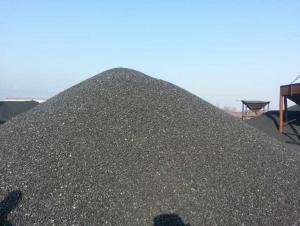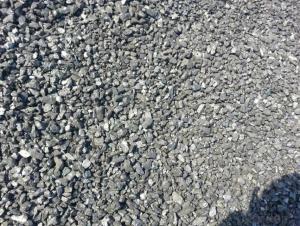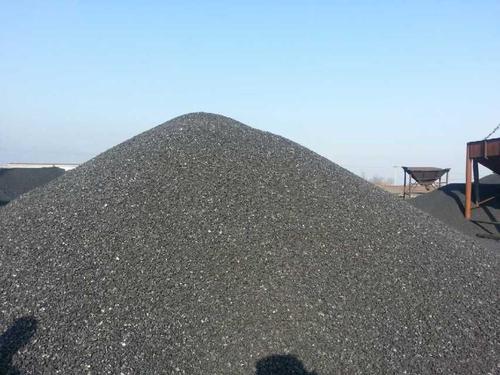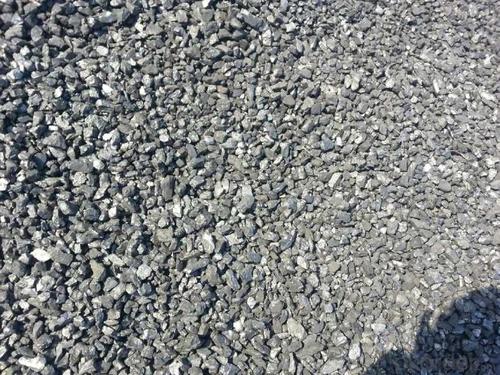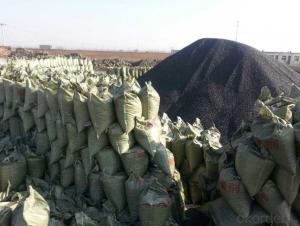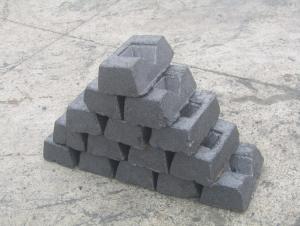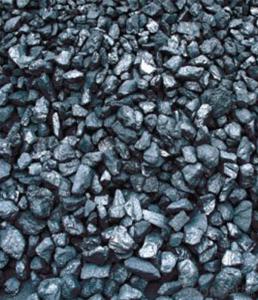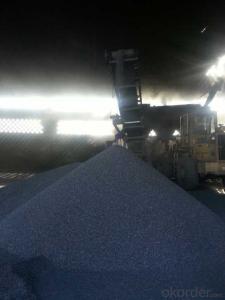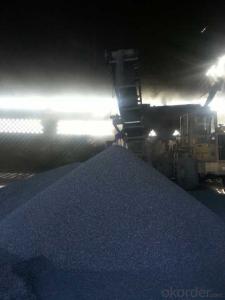Carbon Additive FC90-95 with stable quality
- Loading Port:
- Tianjin
- Payment Terms:
- TT OR LC
- Min Order Qty:
- 20 m.t.
- Supply Capability:
- 3000 m.t./month
OKorder Service Pledge
OKorder Financial Service
You Might Also Like
Packaging & Delivery
25kgs/50kgs/1ton per bag or as buyer's request
Specifications
Calcined Anthracite
Fixed carbon: 90%-95%
S: 0.5% max
Size: 0-3. 3-5.3-15 or as request
It used the high quality anthracite as raw materials through high temperature calcined at over 2000 by the DC electric calciner with results in eliminating the moisture and volatile matter from anthracite efficiently, improving the density and the electric conductivity and strengthening the mechanical strength and anti-oxidation. It has good characteristics with low ash, low resistvity, low sulphur, high carbon and high density. It is the best material for high quality carbon products.
Advantage and competitive of caclined anthracite:
1. strong supply capability
2. fast transportation
3. lower and reasonable price for your reference
4.low sulphur, low ash
5.fixed carbon:95% -90%
6..sulphur:lower than 0.3%
General Specification of Calcined Anthracite:
| FC | 95 | 94 | 93 | 92 | 90 |
| ASH | 4 | 5 | 6 | 6.5 | 8.5 |
| V.M. | 1 | 1 | 1 | 1.5 | 1.5 |
| S | 0.3 | 0.3 | 0.3 | 0.35 | 0.35 |
| MOISTURE | 0.5 | 0.5 | 0.5 | 0.5 | 0.5 |
Pictures

We are also strong at below materials, please contact us if you are interested in any of them:
Calcined Petroleum Coke
Carbon Electrode Paste
Carbon Electrode
- Q: What are the impacts of carbon emissions on glacier retreat?
- Glacier retreat is significantly affected by carbon emissions. Human activities, such as burning fossil fuels and deforestation, release carbon dioxide and other greenhouse gases into the atmosphere, contributing to global warming. This rise in global temperatures directly affects glaciers. Glaciers are massive ice bodies that form over long periods from accumulated snowfall. They serve as natural freshwater reservoirs, providing an essential source of drinking water to millions of people worldwide. However, as carbon emissions cause the Earth's temperature to increase, glaciers melt at a faster rate. The warming climate causes glaciers to lose more ice through melting than they gain through snowfall. This results in a net ice loss, leading to glacier retreat. As glaciers retreat, they not only decrease in size but also become thinner. This reduces their water storage capacity, impacting water availability in regions that rely on glacial meltwater for drinking, irrigation, and hydropower. Moreover, glacier retreat has extensive implications for ecosystems and biodiversity. Glaciers offer unique habitats for various species, including plants, animals, and microorganisms that have adapted to survive in extreme environments. As glaciers vanish, these species must adapt or relocate to other areas, disrupting ecosystem equilibrium. The consequences of glacier retreat extend beyond local and regional scales. Glacial meltwater contributes to rivers and lakes, ensuring a consistent water flow throughout the year. As glaciers shrink, this flow diminishes, leading to water scarcity during dry periods. This poses a threat to agriculture, urban water supplies, and the overall sustainability of ecosystems reliant on stable water sources. Additionally, glacier loss contributes to rising sea levels. When glaciers melt, the water they release flows into the oceans, causing them to expand. This worsens coastal erosion, increases the risk of flooding in low-lying areas, and endangers coastal communities and infrastructure. In conclusion, carbon emissions profoundly impact glacier retreat. The resulting global warming accelerates glacier melting, leading to water scarcity, loss of biodiversity, rising sea levels, and various environmental and socio-economic consequences. It is crucial to address carbon emissions and take action to mitigate climate change in order to preserve these crucial ice formations and the ecosystems and communities that depend on them.
- Q: Can barbecue carbon still have the effect of absorbing formaldehyde?
- 3) photocatalyst, it is like as photosynthesis makes use of natural light catalytic decomposition of formaldehyde, benzene and other harmful gases, and the main component of titanium dioxide photocatalyst is very safe, allowing food and cosmetics to add trace. At present, many brands in the market, Japan in the development of photocatalyst is better.
- Q: Can carbon be recycled?
- Yes, carbon can be recycled. Carbon recycling refers to the process of capturing and reusing carbon dioxide (CO2) emissions instead of releasing them into the atmosphere. There are several methods of carbon recycling, including: 1. Carbon capture and storage (CCS): This process involves capturing CO2 emissions from power plants or industrial facilities and storing them underground or in deep ocean formations. CCS helps prevent the release of CO2 into the atmosphere, reducing its impact on climate change. 2. Carbon capture and utilization (CCU): CCU involves capturing CO2 emissions and converting them into useful products. For example, CO2 can be converted into fuels, chemicals, or building materials through various chemical and biological processes. 3. Enhanced oil recovery (EOR): This technique involves injecting captured CO2 into oil reservoirs to increase the amount of oil that can be recovered. It not only helps to recycle carbon but also increases oil production. 4. Biological carbon sequestration: This method involves using plants, trees, and other biological organisms to absorb CO2 from the atmosphere through photosynthesis. By promoting reforestation, afforestation, and sustainable land management practices, we can increase carbon sequestration and offset emissions. While carbon recycling technologies are still being developed and improved, they offer promising solutions for reducing greenhouse gas emissions and mitigating climate change. By recycling carbon, we can reduce our reliance on fossil fuels, decrease the release of CO2 into the atmosphere, and work towards a more sustainable and low-carbon future.
- Q: How does carbon impact air quality?
- Carbon can have a significant impact on air quality through the release of carbon dioxide (CO2) and other carbon-based pollutants into the atmosphere. The burning of fossil fuels, such as coal, oil, and natural gas, releases large amounts of carbon dioxide, which is a greenhouse gas responsible for climate change. Increased levels of carbon dioxide in the atmosphere contribute to the warming of the Earth's surface, leading to adverse effects on air quality. Furthermore, carbon-based pollutants, including carbon monoxide (CO) and volatile organic compounds (VOCs), can be emitted during the incomplete combustion of fossil fuels or other organic materials. These pollutants have harmful effects on human health and can contribute to the formation of ground-level ozone, a major component of smog. Ozone can cause respiratory problems, lung damage, and worsen existing respiratory conditions such as asthma. Additionally, carbon particles, known as black carbon or soot, are released from the burning of fossil fuels, biomass, and other organic matter. These particles can directly impact air quality by absorbing sunlight and reducing visibility. Moreover, when these particles are inhaled, they can penetrate deep into the lungs, causing respiratory issues and potentially leading to long-term health problems. Reducing carbon emissions is crucial for improving air quality and mitigating the negative impacts on human health and the environment. Transitioning to cleaner and more sustainable energy sources, such as renewable energy, can help reduce carbon emissions and improve air quality. Implementing stricter regulations and emission standards for industries and vehicles can also contribute to reducing carbon pollution and improving overall air quality.
- Q: What are the benefits of carbon-neutral technologies?
- Carbon-neutral technologies have numerous benefits that make them a vital solution in combating climate change and creating a sustainable future. Firstly, these technologies help to reduce greenhouse gas emissions, particularly carbon dioxide, which is the primary contributor to global warming. By transitioning to carbon-neutral technologies, we can significantly decrease our carbon footprint and mitigate the harmful effects of climate change. Secondly, carbon-neutral technologies promote energy efficiency and resource conservation. Many of these technologies, such as renewable energy sources like solar and wind power, harness natural resources that are infinite and readily available. This reduces our reliance on finite fossil fuels, which not only helps to protect the environment but also reduces the volatility of energy prices. Furthermore, embracing carbon-neutral technologies can lead to improved air quality and public health. Traditional energy sources like coal and oil contribute to air pollution and have detrimental health effects on humans, such as respiratory issues and cardiovascular diseases. By transitioning to cleaner technologies, we can reduce air pollution and improve the quality of life for individuals and communities. In addition, carbon-neutral technologies can stimulate economic growth and create new job opportunities. The development, installation, and maintenance of renewable energy infrastructure require skilled workers, leading to job creation and economic development. This transition can also reduce dependency on imported energy sources, leading to greater energy independence and national security. Lastly, by adopting carbon-neutral technologies, we can demonstrate global leadership and contribute to international efforts to combat climate change. Countries that embrace these technologies become role models for others and encourage global cooperation in reducing greenhouse gas emissions. In conclusion, the benefits of carbon-neutral technologies are vast and multidimensional. They not only help mitigate climate change and reduce greenhouse gas emissions but also promote energy efficiency, improve air quality, stimulate economic growth, and contribute to global efforts in creating a sustainable future.
- Q: How does carbon dioxide affect climate change?
- Climate change is significantly influenced by carbon dioxide (CO2), a greenhouse gas. CO2 is released into the atmosphere through natural processes like volcanic eruptions or human activities such as burning fossil fuels. Its presence in the atmosphere traps heat from the sun, preventing it from escaping back into space. This phenomenon is known as the greenhouse effect. Human activities, particularly the burning of fossil fuels like coal, oil, and natural gas, have led to an imbalance in the natural carbon cycle. This has caused an increase in CO2 concentration in the atmosphere, resulting in a rapid rise in global CO2 levels. Consequently, the Earth's surface is warming, and climate patterns are changing. Since the Industrial Revolution, the burning of fossil fuels has significantly elevated atmospheric CO2 levels, leading to an increase in the Earth's average temperature. This temperature rise impacts various aspects of the climate system, causing a range of effects. One of the most visible outcomes of increased CO2 levels is global warming. This warming leads to the melting of glaciers and polar ice, which in turn raises sea levels. Rising sea levels pose a threat to coastal areas and low-lying islands, causing increased flooding, coastal erosion, and potential displacement of communities. Moreover, elevated CO2 levels contribute to more frequent and intense heatwaves, droughts, and wildfires in many regions. These extreme weather events negatively affect agriculture, water availability, and human health. Carbon dioxide also disrupts ecosystems by altering the growth patterns and distribution of plant and animal species. Changes in temperature and precipitation patterns, driven by increased CO2 levels, disturb the delicate balance of life, leading to biodiversity loss and potential species extinction. To mitigate the impacts of CO2 on climate change, it is crucial to reduce greenhouse gas emissions. Transitioning to renewable energy sources, improving energy efficiency, and adopting sustainable practices are important steps in reducing CO2 emissions and limiting the extent of climate change. Additionally, efforts to restore and protect forests and other natural carbon sinks can help absorb and store CO2, thus mitigating its effects on the climate.
- Q: Last night to go to the supermarket to buy 5 batteries, see Toshiba carbon batteries, I finally bought the super alkaline batteries, alkaline batteries and carbon is the difference in where? What kind of battery is best for digital cameras? Thank you
- Alkaline battery discharge point, carbon battery's full name should be carbon zinc batteries (because it is the general level is the carbon rod electrode is the zinc skin), also known as zinc manganese battery, is currently the most common dry battery, it has the characteristics of low price and safe and reliable use, environmental factors based on the consideration.
- Q: What is carbon nanowire?
- Carbon nanowires are one-dimensional structures made entirely of carbon atoms. They are incredibly thin, with diameters ranging from a few nanometers to a few micrometers, while their length can vary from a few micrometers to several centimeters. These nanowires possess exceptional electrical, thermal, and mechanical properties due to their unique structure and composition. Carbon nanowires can be produced through various methods, such as chemical vapor deposition, electrospinning, or template synthesis. They can have different structures, including single-walled or multi-walled, and can be straight or coiled. The properties of carbon nanowires can be further enhanced by incorporating other elements or functional groups into their structure. One of the most significant advantages of carbon nanowires is their high electrical conductivity, which makes them suitable for various electronic and energy applications. They can be used as interconnects in nanoscale devices, electrodes in energy storage devices like batteries and supercapacitors, and in sensors for detecting various substances due to their exceptional sensitivity. Carbon nanowires also exhibit exceptional mechanical properties, such as high tensile strength and flexibility. These properties make them suitable for applications in nanotechnology, including reinforcement in composite materials, nanoscale actuators, or as templates for fabricating other nanoscale structures. Furthermore, carbon nanowires possess excellent thermal conductivity, which makes them potential candidates for thermal management applications, such as heat sinks or as fillers in thermal interface materials. In summary, carbon nanowires are ultrathin carbon-based structures with remarkable electrical, thermal, and mechanical properties. Their unique characteristics make them promising materials for a wide range of applications in electronics, energy, sensing, nanotechnology, and thermal management.
- Q: What kind of industry does high-performance carbon fiber belong to?
- High performance carbon fiber is used in many industries, such as automobiles, bicycles, and even the aviation industry.. If you look at the industry type, many industries have high-performance carbon fiber figure, if divided by the industry attributes, should belong to the emerging industry, the future potential of the industry
- Q: What is the melting point of carbon?
- The melting point of carbon is determined by the form in which it is discovered. There are several forms of pure carbon, such as graphite and diamond. Graphite possesses a melting point of about 3,600 degrees Celsius (6,500 degrees Fahrenheit), whereas diamond has an even higher melting point of roughly 3,827 degrees Celsius (6,920 degrees Fahrenheit). The reason for these elevated melting points lies in the robust covalent bonds between carbon atoms in these structures. However, it is crucial to acknowledge that carbon can also exist in amorphous states, like coal or charcoal, which lack a specific melting point since they undergo a gradual decomposition process upon heating.
Send your message to us
Carbon Additive FC90-95 with stable quality
- Loading Port:
- Tianjin
- Payment Terms:
- TT OR LC
- Min Order Qty:
- 20 m.t.
- Supply Capability:
- 3000 m.t./month
OKorder Service Pledge
OKorder Financial Service
Similar products
Hot products
Hot Searches
Related keywords
